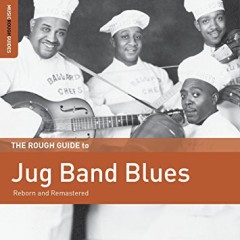The Rough Guide To Jug Band Blues (Reborn And Remastered) [2018]
The Rough Guide To Jug Band Blues (Reborn And Remastered) [2018]

1 –Memphis Sheiks He's In The Jailhouse Now 3:10 2 –Whistler And His Jug Band The Jub Band Special 3:06 3 –Cannon's Jug Stompers Going To Germany 2:29 4 –Birmingham Jug Band Giving It Away 3:02 5 –Earl McDonald's Original Louisville Jug Band Casey Bill 2:46 6 –Tampa Red's Hokum Jug Band It's Tight Like That 2:44 7 –Carolina Peanut Boys This Will Bring You Back 3:02 8 –Daddy Stovepipe & Mississippi Sarah The Spasm 2:49 9 –Minnie Wallace The Old Folks Started It 2:40 10 –King David's Jug Band What's That Tastes Like Gravy 3:04 11 –Seven Gallon Jug Band Wipe 'Em Off 2:40 12 –Memphis Minnie And Her Jug Band Grandpa And Grandma Blues 3:21 13 –Memphis Jug Band Stealin', Stealiin' 2:55 14 –Bob Coleman & The Cincinnati Jug Band Tear It Down 2:45 15 –Clifford 's Louisville Jug Band Mammy O'Mine Blues 3:35 16 –Noah Lewis's Jug Band Ticket Agent Blues 2:38 17 –Jimmie Rodgers & The Louisville Jug Band My Good Gal's Gone Blues 2:44 18 –Jed Davenport & His Beale Street Jug Band Beale Street Breakdown 2:49 19 –Bill Johnson's Louisiana Jug Band Don't Drink It In Here 2:49 20 –Picaninny Jug Band Bottle It Up And Go 2:24 21 –Dixieland Jug Blowers Banjoreno 3:10 22 –Prairie Ramblers Jug Rag 2:49 23 –Jack Kelly & His South Memphis Jug Band Red Ripe Tomatoes 3:01 24 –Old Southern Jug Band Blues, Just Blues, That's All 2:45 25 –Alabama Jug Band Sugar Blues 2:34
By incorporating all manner of homemade instruments, jug bands were hugely popular in America during the 1920s and early 1930s. With an unparalleled vibrancy this ‘do it yourself’ and often overlooked approach to music was highly influential in the history of the blues.
The original jug bands had their origins in the 1890s amongst African-Americans, and were then known as ‘spasm bands’. This ‘do it yourself’ approach to their instrument-making gained immense popularity in America during the 1920s and early 1930s, and became closely linked to the development of the blues. The jug could be earthenware or glass and was played by buzzing one’s lips into its mouth from about an inch away, thus creating a sound somewhere between that of a tuba or trombone. The swoop sounds that could be made gave the impression of sliding notes and a good player could get two octaves out of a good-sized jug. Incorporating all manner of homemade instruments, early jug bands were typically made up of African-American vaudeville and medicine show musicians and played a mixture of blues, ragtime and jazz music with a strong backbeat.
Not only was Memphis a centre for Delta blues during the late 1920s but it was also the home of many of the great jug bands including Will Shade’s Memphis Jug Band and Gus Cannon’s Jug Stompers. These bands developed out of the country blues and songster traditions and created an upbeat and comic sound perfectly suited to entertaining crowds, and far removed from the raw sound of the Delta blues. This allowed them to play all manner of places from street corners to vaudeville stages and saloons. The Memphis Jug Band recorded under several different names for various labels including the Picaninny Jug Band, the Carolina Peanut Boys and the Memphis Sheiks and produced more sides than any other pre-war jug band including the featured classic ‘Stealin’, Stealin’’ which was subsequently recorded by the Grateful Dead. Often referred to as a training ground for musicians, many fine performers passed through the ranks of the Memphis Jug Band including Memphis Minnie who is accompanied here by her own jug band on ‘Grandpa And Grandma Blues’.
Although Memphis became synonymous with the jug band craze the first jug bands to record were in Louisville, where their sound was much more rooted in the jazz influences that came by riverboat from New Orleans, and used the jug more for its novelty value. Clifford Hayes from Kentucky was a multi-instrumentalist and bandleader who was not only the first to record with a jug band (the Old Southern Jug Band) in 1923, but also teamed up with the legendary Jimmie Rodgers on the featured ‘My Good Gal’s Gone Blues’.
Sometimes a stovepipe (usually a section of tin pipe, 3” or 4” in diameter) was played in much the same manner as a jug, perfectly demonstrated by the aptly named ‘Stovepipe No. 1’ aka Sam Jones who recorded with King David’s Jug Band and created a distinctive deep guttural jug sound with his stovepipe. Originally billing himself as ‘Daddy Stovepipe’ he probably didn’t know of the existence of the more famous Maxwell Street one-man band also known as ‘Daddy Stovepipe’, aka Johnny Watson until he first went to record in 1924. His namesake here performs the stomping masterpiece ‘The Spasm’’ with his wife, singer and jug player Mississippi Sarah, with their humorous and unique banter creating a good-time feel in true jug band spirit.
Further highlights include the sublime slide guitar playing of blues legend Tampa Red who formed his own Hokum Jug Band, as well as the frenzied and voice-like harp of Jaybird Coleman, the virtuoso harmonica player of the Birmingham Jug Band. Although other well-known blues performers embraced the jug-band craze, by the mid-1930s it had run its course due to a combination of the depression and the devastating effect of radio on record sales. This collection goes to show how during its heyday this not-often-talked-about genre was a highly influential and most vibrant of musical styles in the history of the blues. ---worldmusic.net
download (mp3 @320 kbs):
yandex mediafire ulozto cloudmailru gett
Last Updated (Monday, 09 July 2018 16:41)








